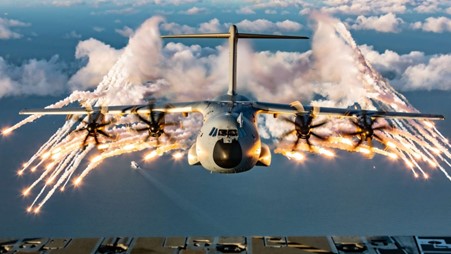
Ex-Air Defender 23 : A NATO Posturing Against Russia

Air Defender 2023 is a massive NATO exercise set to take place from June 12 to June 23, 2023. This is the most extensive live-flying exercise the German Armed Forces – Bundeswehr has ever conducted in more than four decades. In the airspace of Germany, Poland, and the Czech Republic, approximately 250 aircraft of a number of nations will train for their Air Forces’ combined reaction capacity in a crisis.
Germany hopes to project a more assertive military stance by taking the lead role in the wargames, which were initially planned in 2018 in response to Russia’s invasion of Crimea four years earlier. [1] Germany planned to serve as a ‘Multinational Air Group’ (MAG) framework country in 2018. The objective was to train and equip fully operational, large-scale aviation groups in tandem with NATO partners. The strategy called for completing a challenging MAG Exercise (MAGEX) session. This strategy developed the first core idea for a successful aerial exercise.[2]
“Air Defender 23” is the NATO exercise that will include the largest deployment of air assets in the organization’s history. This exercise is a perfect example of the friendship among the NATO continents. With up to 10,000 participants from 25 nations and 250 aircraft, the German Air Force will oversee the air operations as part of the training exercise in European airspace. There will be 23 different types of aircraft participating in Air Defender 23, including F-35s from the United States and the Netherlands, AWACS surveillance planes from NATO and, for the first time, a Japanese Air Force transport plane. Since Operation Desert Storm in 1991 in Iraq, this will be the most extensive US Air National Guard (ANG) aircraft deployment.[3]
Objectives
Air Defender 23 is a multinational exercise organised by NATO to strengthen the alliance and enhance cooperation among its troops. These activities will bolster the alliance’s capacity for global operations. NATO air forces will have to coordinate and work in unison to ensure “flight safety’’, which is a goal that poses significant operational challenges.
In a military crisis, the participating nations want to analyse their air forces’ response and cooperation. At Air Defender 23, participants will be able to evaluate their unified air response and work together to create standard operating procedures (SOPs) for use in times of crisis.
Participants
Various countries as far away as Japan, together with about 250 military aircraft (including B1 strategic bombers, modern F-35 jet fighters, and deadly long-range drones) are scheduled to perform 2000 missions.
The participating Air Forces are primarily from the NATO countries which include the United Kingdom, the United States, Japan, Germany, Belgium, Bulgaria, Croatia, Czech Republic, Denmark, Estonia, Finland, France, Greece, Hungary, Italy, Latvia, Lithuania, Netherlands, Norway, Poland, Romania, Slovenia, Spain, Sweden and Turkey.
“Strength is the best deterrence. There is more to Air Defender 2023 than just deterrence.” Lt. Gen. Michael Loh, the head of the Air National Guard (ANG), stated. “The capacity and credibility of the forces to join together are being shown,” he claimed.[5] The United States ANG has mobilised 100 planes and 2600 soldiers from 42 states. The war exercises will include areas as far-flung as the Baltic and Black Sea regions, which border Russia and as close as the United States and Germany.
Germany is in the driver’s seat and serving as the operations centre. The German Air Force, as the host country’s air force, has assigned 64 aircraft to the exercise; the following planes will take turns exercising above Germany alongside planes from other countries.[6]
- German Eurofighters: 30
- German Tornados: 16
- German A400Ms: 05
- German A330: 03 (AARs for refuelling)
- German LJ35: 02
- German A-4: 02
- German light support helicopters (LUH) 145: 04
Exercise Settings
Air Forces participating in the Exercise will go through drills designed to replicate what might happen in a NATO Article 5 scenario—the collective defence of Alliance territory. As in the baseline scenario, if the enemy takes Rostock, NATO must defend the city under Article 5. The solution is to retake the port and other critical infrastructure, fortify city centres, and launch offensives. NATO’s eastern flank will be practising over Lithuania, Romania, Poland, and the Czech Republic. Europe’s air defences have an air defence gap, and the Allied air forces will train to fill it. Jet fighters will defend against Russian-simulated missile and drone attacks.
Fighter planes from the Luftwaffe and other countries will be stationed at six German locations throughout the Exercise. Schleswig-Holstein, Lower Saxony, Saarland, Brandenburg, Berlin, and Saxony are the other six locations.[7]
Fighter planes and other aircraft will presumably fly over Germany Monday to Friday, dividing the country into three flight corridors—north, east, and south. On weekends, there won’t be any exercise sessions. The airspace is restricted to military usage only during designated times for each flight corridor to ensure flight safety. As a result, certain passenger flights within and between European countries may be impacted by this restriction. The exercise will use altitudes between flight level 100 (about 2,900 metres) and flight level 660 (roughly 18,470 metres), with the exact height being determined by local conditions.
Contemporary air warfare requires high flexibility and adaptability to cope with various challenges. To effectively deploy ground troops, “air sovereignty” is necessary. Air sovereignty relies heavily on multi-role combat aircraft (MRCA). MRCAs will be used in various combat missions in Air Defender 23. MRCAs will be tasked with a wide range of duties throughout the spectrum of military operations. Combat police, air interdiction, counterattack strike, close air support, reconnaissance, and surveillance are all examples of these roles.
All the air forces in the NATO alliance will participate in this exercise to test and revalidate their combined operations and interoperability in realistic circumstances. “With Air Defender 2023, I intend to demonstrate determined Allied Air Power,” declared Lt. Gen. Ingo Gerhartz, Chief of Staff of the German Air Force. The Luftwaffe, the USAF and our European partners will deliver a clear and strong message of credible deterrence in the air.”[8]
Geopolitical Implications
The timing and geographical region of operations of NATO’s most extensive air exercise, Air Defender 23 is strategically planned. Within this window, a “counter-offensive” by the Ukrainians is possible.[9].[10] Ukraine has made evident that one of its key objectives is reclaiming all the land Russia took over in 2014. This would lead to returning to the border geometries in place as in 1991, after the dissolution of the Soviet Union. Russia is preparing for all possible outcomes which can emanate from Air Defender 2023 military exercises, which NATO is conducting. Russia has deployed 3,000 tanks it had been keeping as reserve. Locations include Murmansk, St. Petersburg, Belgorod, etc., in Russia.[11]
The Indo-Pacific area is relevant to the exercise as well. By practicing rapid deployment in Europe and other regions, allied air forces can better safeguard NATO partners like South Korea and Japan. Climate change is a primary concern for environmentalists. Germans should prepare for noise, millions of litres of gasoline pollution, and airline cancellations and delays despite official claims to the contrary. Das Erste has reported concerns.[12]
Conclusion
Air Defender-23 is a multinational air operation exercise that will take place in Europe. It would be the greatest air warfare operations exercise conducted by NATO since the organization’s inception. The Russian invasion of Ukraine in February of the previous year caused concern among the members of NATO and as a result, attempts to extend and strengthen the military alliance have escalated. Even though the exercise had been planned for years, it is slated to bring all NATO air forces to a common platform this year. The purpose of the exercise is to display NATO’s air power while also demonstrating the adaptability and responsiveness of Air Forces as first responders. Nevertheless, any escalation in the Russia-Ukraine conflict will harm the Global economy, food, and energy needs.
****************************************************************************************************************
[1] Bojan Pancevski, “NATO to Flex Muscles with Largest-Ever Air Drills Near Ukraine, Russia”, WSWJ, June 7, 2023 https://www.wsj.com/articles/nato-to-flex-muscles-with-largest-ever-air-drills-near-ukraine-russia-b6873dd6?mod=Searchresults_pos1&page=1. Accessed on June 9, 2023.
[2] “Air Defender 23 – years of preparation to get 200 aircraft in the air”, Bundeswehr, March 28, 2023, https://www.bundeswehr.de/en/jahrelange-vorbereitung-fuer-air-defender-2023-5605588. Accessed on June 8, 2023.
[3] Djole, Twitter, Jun 1, 2023, https://twitter.com/onlydjole/status/1664258420323627012. Accessed on June 9, 2023.
[4] “Air Defender 23”, Bundeswehr, March 28, 2023, https://www.bundeswehr.de/en/organization/german-air-force/air-defender-23. Accessed on June 8, 2023.
[5] Air National Guard, Official ANG Twitter Handle, Twitter, June 7, 2023, https://twitter.com/AirNatlGuard/status/1666476304634355713. Accessed on June 10, 2023.
[6] Ibid Bundeswehr.
[7] “Air Defender: More than 200 NATO jets will be transferred to Germany”, News Md, May 23, 2023,
https://newsrnd.com/news/2023-05-23-air-defender–more-than-200-nato-jets-will-be-transferred-to-germany.B1-H07tqSn.html. Accessed on June 9, 2023.
[8] “Exercise Air Defender Update: More Aircraft Deployment Details Revealed”, Key Aero, February 20, 2023. https://www.key.aero/article/exercise-air-defender-update-more-aircraft-deployment-details-revealed. Accessed on June 9, 2023.
[9] Djole, Twitter, Jun 1, 2023, https://twitter.com/onlydjole/status/1664256469548642304. Accessed on June 9, 2023.
[10] “Ukraine strikes back”, The Economist, June 10th–16th 2023, p9, June 10, 2023, https://www.economist.com /leaders/2023/06/08/ukraine-strikes-back. Accessed on June 10, 2023.
[11] “Global-Intel”, Jun 2, 2023, https://t.me/s/Global_Intel?q=Air+Defender+2023. Accessed on June 9, 2023.
[12] “Sprinter”, Twitter, Jun 9, 2023, https://twitter.com/Sprinter99880. Accessed on June 9, 2023.
Disclaimer
The opinions expressed in this article are the author’s own and do not reflect the views of Chanakya Forum. All information provided in this article including timeliness, completeness, accuracy, suitability or validity of information referenced therein, is the sole responsibility of the author. www.chanakyaforum.com does not assume any responsibility for the same.
Chanakya Forum is now on . Click here to join our channel (@ChanakyaForum) and stay updated with the latest headlines and articles.
Important
We work round the clock to bring you the finest articles and updates from around the world. There is a team that works tirelessly to ensure that you have a seamless reading experience. But all this costs money. Please support us so that we keep doing what we do best. Happy Reading
Support Us





















POST COMMENTS (0)